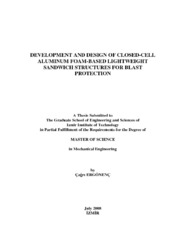Please use this identifier to cite or link to this item:
https://hdl.handle.net/11147/3937Full metadata record
| DC Field | Value | Language |
|---|---|---|
| dc.contributor.advisor | Taşdemirci, Alper | - |
| dc.contributor.author | Ergönenç, Çağrı | - |
| dc.date.accessioned | 2014-07-22T13:52:47Z | - |
| dc.date.available | 2014-07-22T13:52:47Z | - |
| dc.date.issued | 2008 | - |
| dc.identifier.uri | http://hdl.handle.net/11147/3937 | - |
| dc.description | Thesis (Master)--Izmir Institute of Technology, Mechanical Engineering, Izmir, 2008 | en_US |
| dc.description | Includes bibliographical references (leaves: 65-66) | en_US |
| dc.description | Text in English; Abstract: Turkish and English | en_US |
| dc.description | xi, 66 leaves | en_US |
| dc.description.abstract | Blast performance and energy absorption capability of closed-cell aluminum foam based lightweight sandwich structures were investigated by a coupled experimental and numerical technique to find out the effect of face and core material on the blast response. Split Hopkinson Pressure Bar Testing Method (SHPB) was used to characterize the mechanical properties of constituents of the sandwich structures at high strain rates. A SHPB set-up, a high strain rate testing apparatus which can successfully create blast load at laboratory scales, was built at IZTECH on behalf of a TUBITAK project (106M353). The high strain rate test data were used as an input for the numerical models. Closed-cell aluminum foam was chosen as core material for sandwich structures owing to its high energy absorption characteristic while deforming plastically. Finite element modeling of sandwich structures subjected to blast loading were performed for different core and face thicknesses and face materials in order to investigate their effects on the blast load mitigation.Experimentally and numerically revealed conclusions are; sandwich structures absorbed more energies than the bulk materials from %50 to %150 when appropriate combinations of core and face materials are used. Numerical simulations showed that 6.3 and 7.2 cm thick foam interlayer are the most efficient foam thicknesses for a 9 cm sandwich plate against 10 kg TNT blast load. Another important conclusion is for the same blast threat i.e. 10 kg of TNT, AISI 4340 Steel is the most effective face material. | en_US |
| dc.language.iso | en | en_US |
| dc.publisher | Izmir Institute of Technology | en_US |
| dc.rights | info:eu-repo/semantics/openAccess | en_US |
| dc.subject.lcc | TA492.S25 E674 2008 | en |
| dc.subject.lcsh | Sandwich consruction | en |
| dc.subject.lcsh | Lightweight onsruction | en |
| dc.subject.lcsh | Blast effec | en |
| dc.title | Development and Design of Closed-Cell Aluminum Foam-Based Lightweight Sandwich Structures for Blast Protection | en_US |
| dc.type | Master Thesis | en_US |
| dc.institutionauthor | Ergönenç, Çağrı | - |
| dc.department | Thesis (Master)--İzmir Institute of Technology, Mechanical Engineering | en_US |
| dc.relation.publicationcategory | Tez | en_US |
| dc.identifier.wosquality | N/A | - |
| dc.identifier.scopusquality | N/A | - |
| item.openairecristype | http://purl.org/coar/resource_type/c_18cf | - |
| item.languageiso639-1 | en | - |
| item.openairetype | Master Thesis | - |
| item.grantfulltext | open | - |
| item.fulltext | With Fulltext | - |
| item.cerifentitytype | Publications | - |
| Appears in Collections: | Master Degree / Yüksek Lisans Tezleri | |
Files in This Item:
| File | Description | Size | Format | |
|---|---|---|---|---|
| T000686.pdf | MasterThesis | 4.44 MB | Adobe PDF |  View/Open |
CORE Recommender
Page view(s)
370
checked on Mar 31, 2025
Download(s)
136
checked on Mar 31, 2025
Google ScholarTM
Check
Items in GCRIS Repository are protected by copyright, with all rights reserved, unless otherwise indicated.